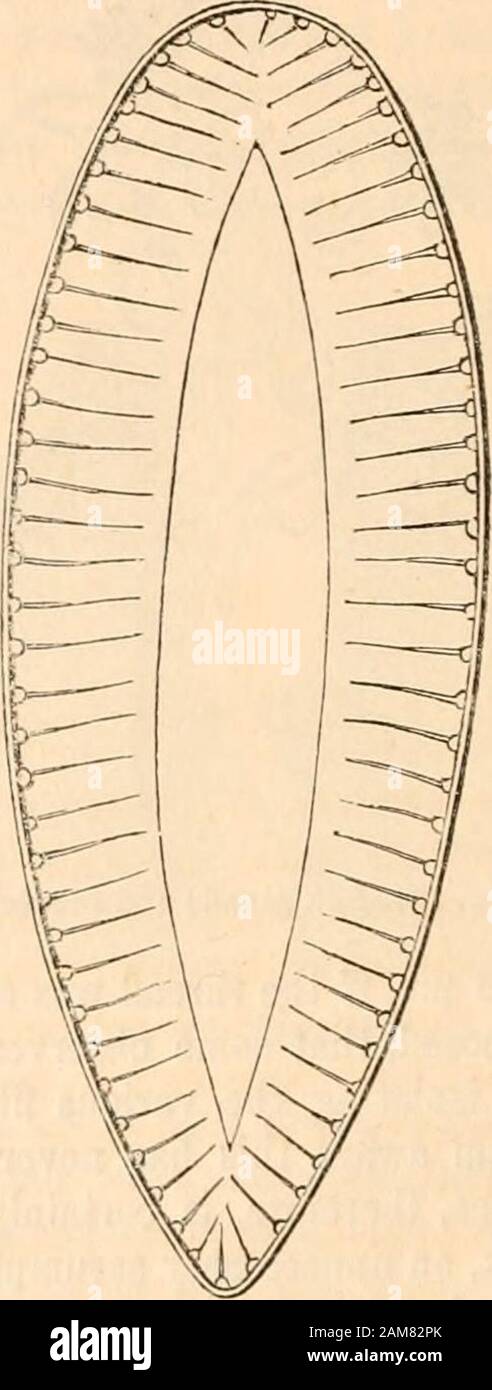Hardwicke's science-gossip : an illustrated medium of interchange and gossip for students and lovers of nature . .Stauroneis (n. s.) x 1000. Fig. 130. Pinnularia isocephala x 400. Surirella Craticula (Ehr.) This form occurs butrarely, and although a widely distributed species,has never been found in any quantity. It has beensuggested by several observers that it is an ab-normal state of some species of Navicula. Mr. Norman, in his List of Diatomaceae occurring inthe Neighbourhood of Hull, published 1865, says : This is certainly wrongly referred to Surirella;it has a distinct central nodule, a

Image details
Contributor:
The Reading Room / Alamy Stock PhotoImage ID:
2AM82PKFile size:
7.2 MB (200.9 KB Compressed download)Releases:
Model - no | Property - noDo I need a release?Dimensions:
973 x 2570 px | 8.2 x 21.8 cm | 3.2 x 8.6 inches | 300dpiMore information:
This image is a public domain image, which means either that copyright has expired in the image or the copyright holder has waived their copyright. Alamy charges you a fee for access to the high resolution copy of the image.
This image could have imperfections as it’s either historical or reportage.
Hardwicke's science-gossip : an illustrated medium of interchange and gossip for students and lovers of nature . .Stauroneis (n. s.) x 1000. Fig. 130. Pinnularia isocephala x 400. Surirella Craticula (Ehr.) This form occurs butrarely, and although a widely distributed species, has never been found in any quantity. It has beensuggested by several observers that it is an ab-normal state of some species of Navicula. Mr. Norman, in his List of Diatomaceae occurring inthe Neighbourhood of Hull, published 1865, says : This is certainly wrongly referred to Surirella;it has a distinct central nodule, and hence it must beremoved to Navicula; and in all probability is a stateof N. cuspidata. In a gathering from New Zealandit occurs with the outline of Navicula ambigua. Surirella elegans (Ehr.) Valve oval and elliptical, alse distinct, canal iculi delicate, 5 to 6 in 001, be-coming indistinct as they approach the centre.This species was only known to Ehrenberg by thefragment figured by him. The author of theSynopsis seems to have overlooked or confoundedit with Surirella nobilis. It occurs in several foreign. Fig. 132. Surirella elegans x 400. and British deposits, and in recent gatherings fromScotter Common, Market Weighton Canal, Hull, and Devizes; in my slide from the last-mentionedlocality it is very plentiful and fine; in the PerleysMeadow deposit it occurs but sparingly, and differsslightly from the species found in the above-namedlocalities. The canaliculi are somewhat closer, andreach a narrow, well-defined, lanceolate blank space(fig. 132, x 400).* Surirella cardinalis (n. sp.—F. Kitton). Valvebroadly ovate, aire distinct, canaliculi marginal, absent from the top of the valve 6 to 7 in 001, central portion of valve faintly granulate (fig. 133, x 400). It is not without some misgivings that Imake the above a new species; it may possibly beonly a variety of S. elegans, but the short canaliculi * The lanceolate space is too distinct in the figure. June 1, 1868.] HARDWICKES S